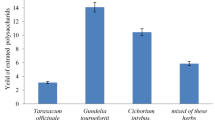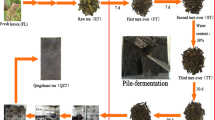Abstract
Ssanghwa-tang is a medicinal formula that is widely prescribed in Korea to decrease fatigue after an illness. Fermented herbal medicines might be made more efficacious than conventional herbal medicines by increasing the absorption and bioavailability of the active compounds. In this study, Ssanghwa-tang was fermented to produce bioconversion compositions using Lactobacillus fermentum, and six peaks were decreased, four peaks were increased and one peak newly appeared in the HPLC-DAD chromatogram. The structures of the newly-appearing compound (1) and increased (2–5) compounds were identified as follows using NMR and MS: liquiritigenin (1), nodakenetin (2), cinnamyl alcohol (3), decursinol (4), and benzoic acid (5). The decreased compounds were identified to be paeoniflorin (6), liquiritin (7), nodakenin (8), cinnamaldehyde (9), decursin (10), and decursinol angelate (11) using HPLC-DAD analysis with authentic compounds. The high performance liquid chromatography method was used to quantify the eleven constituents in Ssanghwa-tang and fermented Ssanghwa-tang. All calibration curves of the standard compounds exhibited excellent linearity with a R2 > 0.9940.
Similar content being viewed by others
References
Won, J. B., J. Y. Ma, Y. R. Um, and C. J. Ma (2010) Simultaneous determination of five marker constituents in Ssanghwa tang by HPLC/DAD. Pharmcogn. Mag. 6: 111–115.
Park, W. K. and S. D. Park (1995) Effects of Ssanghwa-Tang on the antifatigue action and brain levels of norepinephrine, serotonin, 5-hydroxyindole-acetic acid and dopamine. The J. Jeahan Oriental Med. Acad. 1: 130–145.
Han, D. S., H. K. Lee, and H. J. Cho (1983) Analgesic and anti-convulsionary effects of Ssanghwa-Tang. Kor. J. Pharmacog. 14: 60–63.
Jung, J. C. and D. K. Park (1986) Studies on CNS-depression and anti-inflammatory action of Ssangwhatang. J. Kor. Pharm. Sci. 16: 24–30.
Hyun, D. H., J. K. Kim, D. Y. Choi, C. H. Kim, and W. H. Park (1997) Inhibition of growth of the established 3-methyl-DABinduced mammary cancer in mice and lung endothelial cells by Gamissangwhatang. Kor. J. Oriental Med. Pathol. 11: 108–112.
Kim, J. K. (2005) Smooth muscle relaxation by the herbal medicine Ssanghwatang associated with nitric oxide synthase activation and nitric oxide production. Ph.D. Thesis. University of Wonkwang, Iksan-si, Jeollabuk-do, Korea.
Shim, K. S., J. H. Lee, and J. Y. Ma (2010) Effect of Ssangwhatang fermented by Lactobacillus fermentum on osteoclast differentiation and osteoporosis of ovariectomized rats. Kor. J. Ori. Med. 16: 149–155.
Shim, K. S., J. H. Lee, C. J. Ma, Y. H. Lee, S. U. Choi, and J. Y. Ma (2010) Inhibitory effect of Ssangwha-tang on bone loss in ovariectomized rats. Animal cells and systems 14: 283–289.
Cho, T. Y., C. K. Shim, M. H. Lee, and S. K. Kim (1987) Effects of blended Chinese traditional medicine, SsangWhaTang, on hepatic clearance of sulfobromophthalein in rats. J. Kor. Pharm. Sci. 17: 89–93.
Chien, H. L., H. Y. Huang, and C. C. Chou (2006) Transformation of isoflavone phytoestrogens during the fermentation of soymilk with lactic acid bacteria and bifidobacteria. Food Microbiol. 23: 772–778.
Trinh, H. T., S. J. Han, S. W. Kim, Y. C. Lee, and D. H. Kim (2007) Bifidus fermentation increase hypolipidemic and hypoglycemic effects of red ginseng. J. Microbiol. Biotechn. 17: 1127–1133.
Okabe, Y., T. Shimazu, and H. Tanimoto (2011) Higher bioavailability of isoflavones after a single ingestion of aglyconerich fermented soybeans compared with glucoside-rich nonfermented soybeans in Japanese postmenopausal women. J. Sci. Food Agric. 91: 658–663.
Wei, Q. K., T. R. Chen, and J. T. Chen (2007) Using of Lactobacillus and Bifidobacterium to product the isoflavone aglycones in fermented soymilk. Int. J. Food Microbiol. 117: 120–124.
Choi, J. H., J. N. Choi, S. Y. Lee, S. J. Lee, K. H. Kim, and Y. K. Kim (2010) Inhibitory activity of diacylglycerol acyltransferase by glabrol isolated from the roots of licorice. Arch. Pharm. Res. 33: 237–242.
Lee, S. H., D. S. Shin, J. S. Kim, K. B. Oh, and S. S. Kang (2003) Antibacterial Coumarins from Angelica gigas Roots. Arch. Pharm. Res. 26: 449–452.
Pouchert, C. and J. Behnke (1993) The Aldrich Library of 13C and 1H FT NMR spectra. p. 392.1st ed., Aldrich Chemical Co., St. Louis, USA.
Lee, J. H., H. B. Bang, S. Y. Han, and J. G. Jun (2007) An efficient synthesis of (+)-decursinol from umbelliferone. Tetrahedron Lett. 48: 2889–2892.
Pouchert, C. and J. Behnke (1993) The Aldrich Library of 13C and 1H FT NMR spectra. p. 1063. 1st ed., Aldrich Chemical Co., St. Louis, USA.
Kim, Y. W., Y. M. Kim, Y. M. Yang, H. Y. Kay, W. D. Kim, J. W. Lee, S. J. Hwang, and S. G. Kim (2011) Inhibition of LXRalpha dependent steatosis and oxidative injury by liquiritigenin, a licorice flavonoid, as mediated with Nrf2 activation. Antioxid. Redox. Signal 14: 733–745.
Liu, R. T., L. B. Zou, J. Y. Fu, and Q. J. Lu (2010) Promotion of rat brain-derived progenitor cell neurogenesis by liquiritigenin treatment: underlying mechanisms. Neurosci. Lett. 481: 139–143.
Lee, Y. S., S. H. Kim, S. H. Jung, J. K. Kim, C. H. Pan, and S. S. Lim (2010) Aldose reductase inhibitory compounds from Glycyrrhiza uralensis. Biol. Pharm. Bull. 33: 917–921.
Kim, Y. W., R. J. Zhao, S. J. Park, J. R. Lee, I. J. Cho, C. H. Yang, S. G. Kim, and S. C. Kim (2008) Anti-inflammatory effects of liquiritigenin as a consequence of the inhibition of NF-kappaB-dependent iNOS and proinflammatory cytokines production. Br. J. Pharmacol. 154: 165–173.
Mersereau, J. E., N. Levy, R. E. Staub, S. Baggett, T. Zogovic, S. Chow, W. A. Ricke, M. Tagliaferri, I. Cohen, L. F. Bjeldanes, and D. C. Leitman (2008) Liquiritigenin is a plant-derived highly selective estrogen receptor beta agonist. Mol. Cell Endocrinol. 283: 49–57.
Shin, Y. W., E. A. Bae, B. Lee, S. H. Lee, J. A. Kim, Y. S. Kim, and D. H. Kim (2007) In vitro and in vivo antiallergic effects of Glycyrrhiza glabra and its components. Planta Med. 73: 257–261.
Lee, M. H., Y. P. Lin, F. L. Hsu, G. R. Zhan, and K. Y. Yen (2006) Bioactive constituents of Spatholobus suberectus in regulating tyrosinase-related proteins and mRNA in HEMn cells. Phytochem. 67: 1262–1270.
Saeed, M. A. and A. W. Sabir (2008) Irritant and cytotoxic coumarins from Angelica glauca Edgew roots. J. Asian Nat. Prod. Res. 10: 49–58.
Kang, S. Y. and Y. C. Kim (2007) Neuroprotective coumarins from the root of Angelica gigas: Structure-activity relationships. Arch. Pharm. Res. 30: 1368–1373.
Ng, L. T. and S. J. Wu (2009) Antiproliferative activity of Cinnamomum cassia constituents and effects of pifithrin-alpha on their apoptotic signaling pathways in Hep G2 cells. Evid. Based Complement. Alternat. Med. doi:10.1093/ecam/nep220.
Chang, K. S., J. H. Tak, S. I. Kim, W. J. Lee, and Y. J. Ahn (2006) Repellency of Cinnamomum cassia bark compounds and cream containing cassia oil to Aedes aegypti (Diptera: Culicidae) under laboratory and indoor conditions. Pest Manag. Sci. 62: 1032–1038.
Lee, H. S. (2002) Inhibitory activity of Cinnamomum cassia bark-derived component against rat lens aldose reductase. J. Pharm. Pharm. Sci. 5: 226–230.
Lee, H. S., B. S. Kim, and M. K. Kim (2002) Suppression effect of Cinnamomum cassia bark-derived component on nitric oxide synthase. J. Agric. Food Chem. 50: 7700–7703.
Zucca, P., M. Littarru, A. Rescigno, and E. Sanjust (2009) Cofactor recycling for selective enzymatic biotransformation of cinnamaldehyde to cinnamyl alcohol. Biosci. Biotechnol. Biochem. 73: 1224–1226.
Choi, S. S., K. J. Han, J. K. Lee, H. K. Lee, E. J. Han, D. H. Kim, and H. W. Suh (2003) Antinociceptive mechanisms of orally administered decursinol in the mouse. Life Sci. 73: 471–485.
Yan, J. J., D. H. Kim, Y. S. Moon, J. S. Jung, E. M. Ahn, N. I. Baek, and D. K. Song (2004) Protection against â-amyloid peptide-induced memory impairment with long-term administration of extract of Angelica gigas or decursinol in mice. Prog. Neuropsychopharmacol. Biol. Psychiatry 28: 25–30.
Son, S. H., M. J. Kim, W. Y. Chung, J. A. Son, Y. S. Kim, Y. C. Kim, S. S. Kang, S. K. Lee, and K. K. Park (2009) Decursin and decursinol inhibit VEGF-induced angiogenesis by blocking the activation of extracellular signal-regulated kinase and c-Jun Nterminal kinase. Cancer Lett. 280: 86–92.
Li, Z., Y. Sun, X. Yan, and F. Meng (2010) Study on QSTR of benzoic acid compounds with MCI. Int. J. Mol. Sci. 11: 1228–1235.
Choi, J. W., K. T. Lee, H. Ka, W. T. Jung, H. J. Jung, and H. J. Park (2001) Constituents of the essential oil of the Cinnamomum cassia stem bark and the biological properties. Arch. Pharm. Res. 24: 418–423.
Ping, G., W. H. Huang, F. Q. Yang, J. Li, and S. P. Li (2010) Pressurized liquid extraction and GC-MS analysis for simultaneous determination of seven components in Cinnamomum cassia and the effect of sample preparation. J. Sep. Sci. 33: 2341–2348.
Wang, R., R. J. Wang, and B. Yang (2011) Comparison of volatile compound composition Of cinnamon (Cinnamomum cassia PRESL) bark prepared by hydrodistillation and headspace solod phase microextraction. J. Food Proc. Eng. 34: 175–185.
Kang, S. Y., K. Y. Lee, S. H. Sung, and Y. C. Kim (2005) Four new neuroprotective dihydropyranocoumarins from Angelica gigas. J. Nat. Prod. 68: 56–59.
Kang, S. Y., K. Y. Lee, S. H. Sung, M. J. Park, and Y. C. Kim (2001) Coumarins isolated from Angelica gigas inhibit acetylcholinesterase: Structure -activity relationships. J. Nat. Prod. 64: 683–685.
Izumi, T., M. K. Piskula, S. Osawa, A. Obata, K. Tobe, M. Saito, S. Kataoka, Y. Kubota, and M. Kikuchi (2000) Soy isoflavone aglycones are absorbed faster and in higher amounts than their glucosides in humans. J. Nutr. 130: 1695–1699.
Hasegawa, H. (2004) Proof of the mysterious efficacy of ginseng: basic and clinical trials: Metabolic activation of ginsenoside: Deglycosylation by intestinal bacteria and esterification with fatty acid. J. Pharmacol. Sci. 95: 153–157.
Hubert, J., M. Berger, F. Nepveu, F. Paul, and J. Dayde (2008) Effects of fermentation on the phytochemical composition and antioxidant properties of soy germ. Food Chem. 109: 709–721.
Author information
Authors and Affiliations
Corresponding author
Additional information
These authors contributed equally to this work.
Rights and permissions
About this article
Cite this article
Yang, M.C., Kim, DS. & Ma, J.Y. Bioconversion composition of Ssanghwa-tang fermented by Lactobacillus fermentum . Biotechnol Bioproc E 17, 84–92 (2012). https://doi.org/10.1007/s12257-011-0296-z
Received:
Revised:
Accepted:
Published:
Issue Date:
DOI: https://doi.org/10.1007/s12257-011-0296-z




